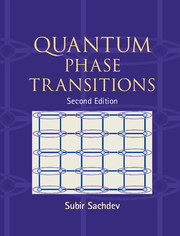Book contents
- Frontmatter
- Contents
- From the Preface to the first edition
- Preface to the second edition
- Part I Introduction
- Part II A first course
- Part III Nonzero temperatures
- 10 The Ising chain in a transverse field
- 11 Quantum rotor models: large-N limit
- 12 The d = 1, O(N ≥ 3) rotor models
- 13 The d = 2, 0(N ≥ 3) rotor models
- 14 Physics close to and above the upper-critical dimension
- 15 Transport in d = 2
- Part IV Other models
- References
- Index
11 - Quantum rotor models: large-N limit
from Part III - Nonzero temperatures
Published online by Cambridge University Press: 16 May 2011
- Frontmatter
- Contents
- From the Preface to the first edition
- Preface to the second edition
- Part I Introduction
- Part II A first course
- Part III Nonzero temperatures
- 10 The Ising chain in a transverse field
- 11 Quantum rotor models: large-N limit
- 12 The d = 1, O(N ≥ 3) rotor models
- 13 The d = 2, 0(N ≥ 3) rotor models
- 14 Physics close to and above the upper-critical dimension
- 15 Transport in d = 2
- Part IV Other models
- References
- Index
Summary
This chapter turns to the O(N) quantum rotor studied earlier in Chapter 6. We extend the earlier results to T > 0 aided by an exact solution obtained in the N → ∞ limit.
The quantum Ising model studied in Chapter 10 had a discrete Z2 symmetry. An important new ingredient in the rotor models is the presence of a continuous symmetry: the physics is invariant under a uniform, global O(N) transformation on the orientation of the rotors, which is broken in the magnetically ordered state. Thus we have to use ideas on the spin stiffness which were introduced in Chapter 8. Apart from this, much of the technology and the physical ideas introduced earlier for the d = 1 Ising chain generalize straightforwardly, although we are no longer able to obtain exact results for crossover functions at finite N. The characterization of the physics in terms of three regions separated by smooth crossovers, the high-T and the two low-T regions on either side of the quantum critical point, continues to be extremely useful and is again the basis of our discussion. Because we consider models in spatial dimensions d > 1, it is possible to have a thermodynamic phase transition at a nonzero temperature, as in Fig. 1.2b. We are particularly interested in the interplay between the critical singularities of the finite-temperature transition and those of the quantum critical point.
- Type
- Chapter
- Information
- Quantum Phase Transitions , pp. 171 - 189Publisher: Cambridge University PressPrint publication year: 2011



